First built in 1859, this lighthouse looking over Portland harbour used to be on the other side of the bay. Now it sits on this grassy bluff, with lucky residents’ gardens just yards away.
My experience at the lighthouse
It was a cold, damp winter’s day when we visited Portland in the far west of Victoria, and had a brief look at the lighthouse on Whalers’ Bluff.
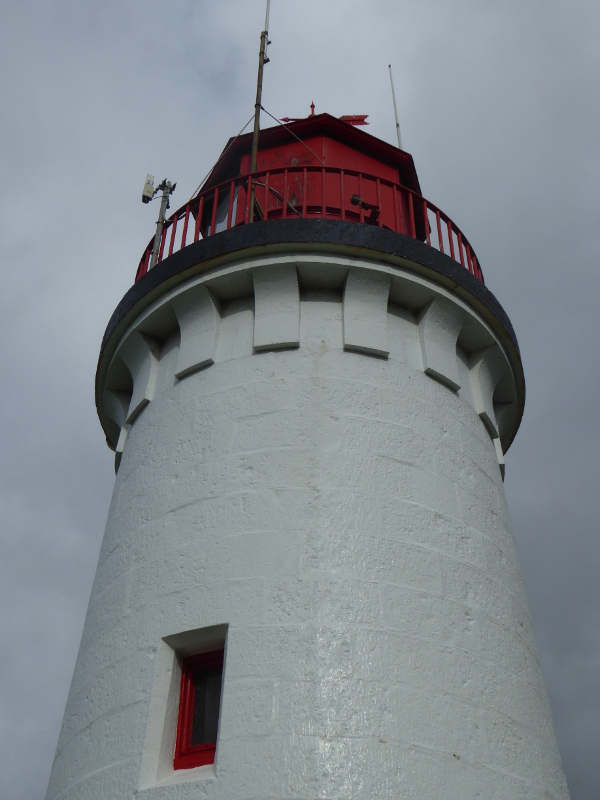
It’s a stubby little lighthouse, sitting on a green grassy area just a few metres from residential housing on the north side of town. It still operates, apparently, though we were not there in darkness and didn’t see the red or white lights which still shine every 30 seconds or so, presumably not visible from those homes right by the lighthouse, since they shine out to sea, though I couldn’t help thinking it’d be great to have a working lighthouse standing right by your back garden fence.
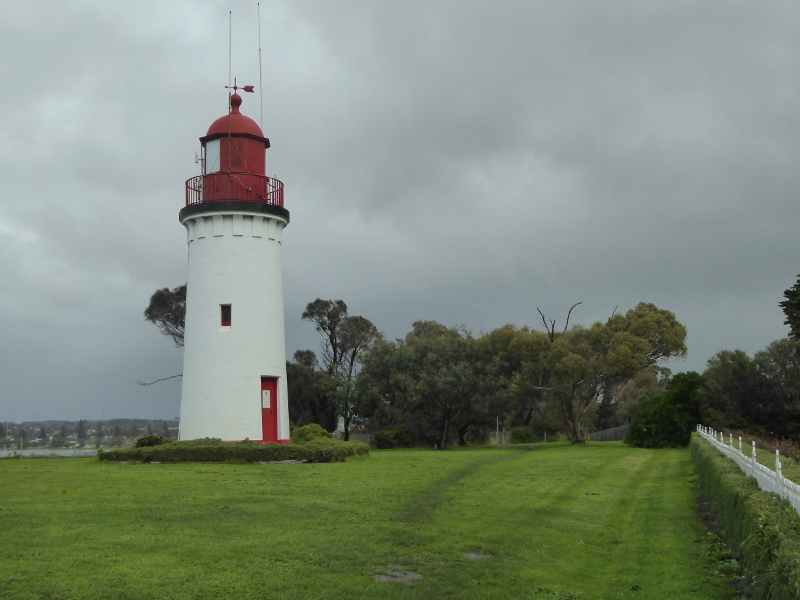
I’d done a bit of research before coming here so knew that the whole lighthouse and outbuildings had been transferred around 1890 from the other side of the bay when big guns were brought in to defend the port on what was then called Battery Point. There’s no sign of the ‘battery’ anymore, except for the name ‘Battery Lane’, which I assume is near to where this lighthouse once stood, over near the modern-day port.
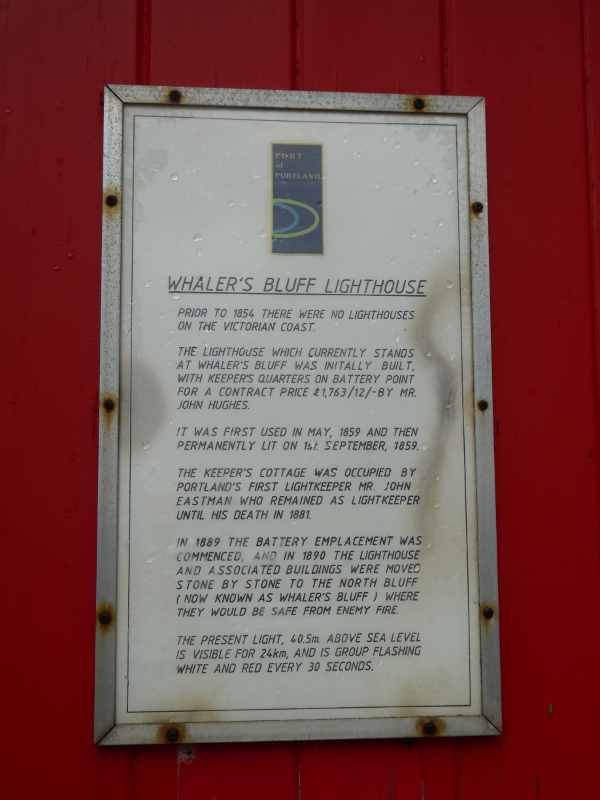
What I forgot to do, as we rushed around the small reserve taking in the views and taking a few photos for Vintage Victoria, was to check whether the old keeper’s cottages are still standing, in among the more modern looking blocks that have been put up on the road near the lighthouse now. Can anyone help with that, and if they are gone, when were they knocked down? Or is the bed and breakfast advertised nearby actually the home of the former keepers?
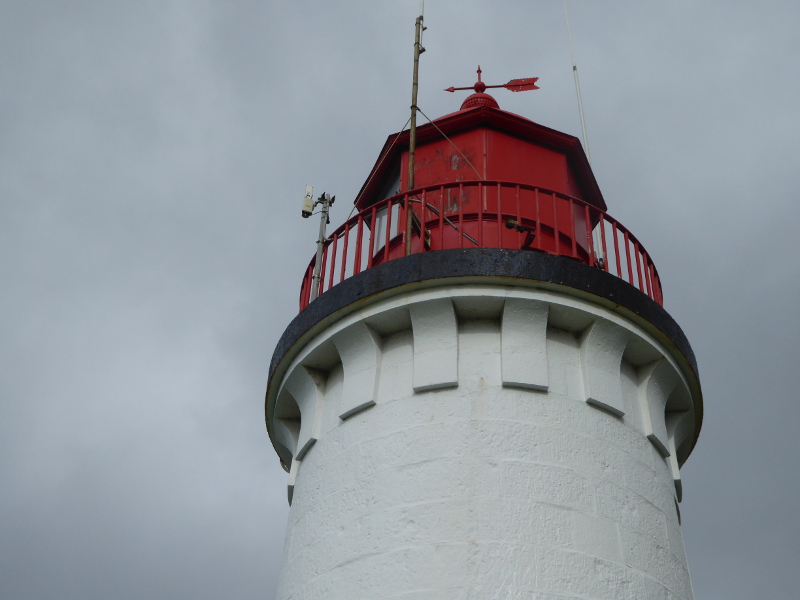
The lighthouse looks right over the bay and the port of Portland, which must look very different now from the early years when Portland’s lighthouse was first built. Gone are the original piers (there used to be three of them apparently, the last one demolished only a couple of years ago), gone are the sea baths, and the port itself now looks fairly modern and developed. There’s certainly no sense of Portland looking like a quaint English village, as one writer from the 19th century I found on Trove, described the place.
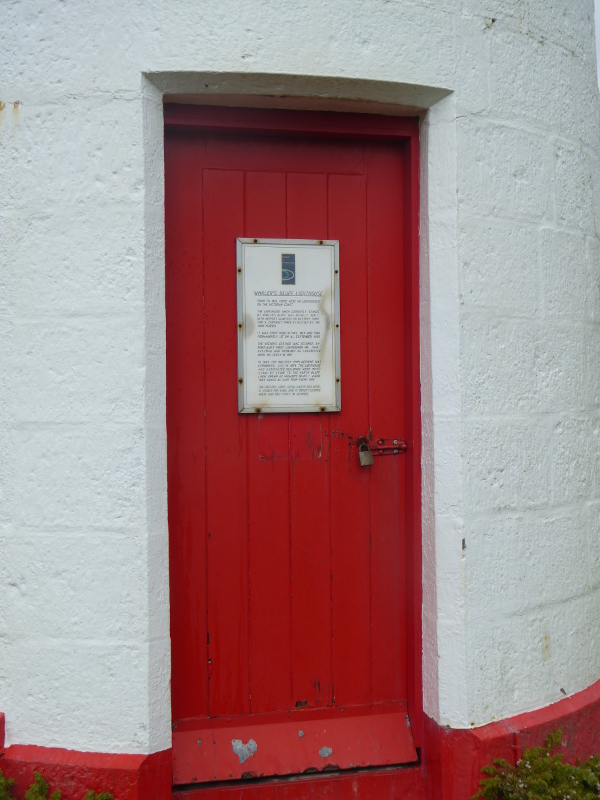
You can’t get inside the lighthouse itself these days, sadly. The red wooden door is padlocked, with just a small noticeboard with some brief historical details on the building and its past.
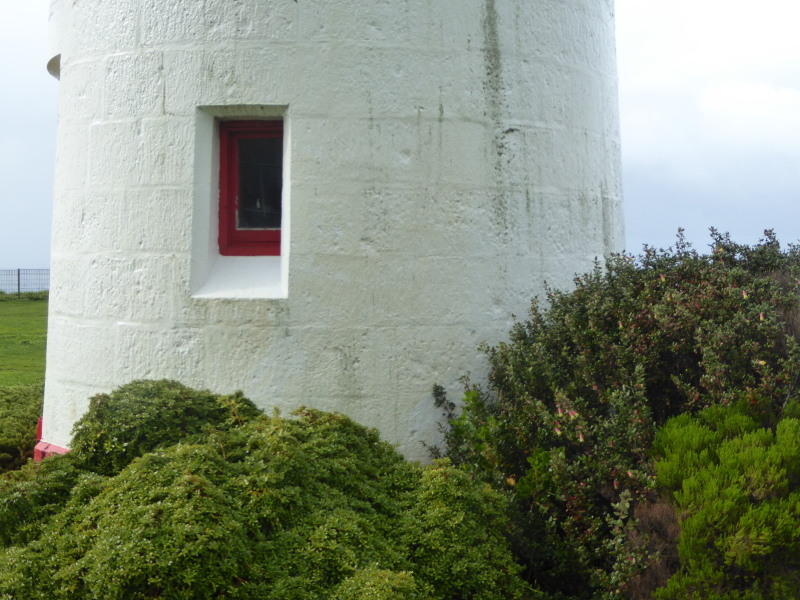
It’s quite an attractive structure, though, with its red window frames and red head, or lantern top and balcony looking out over the bay.
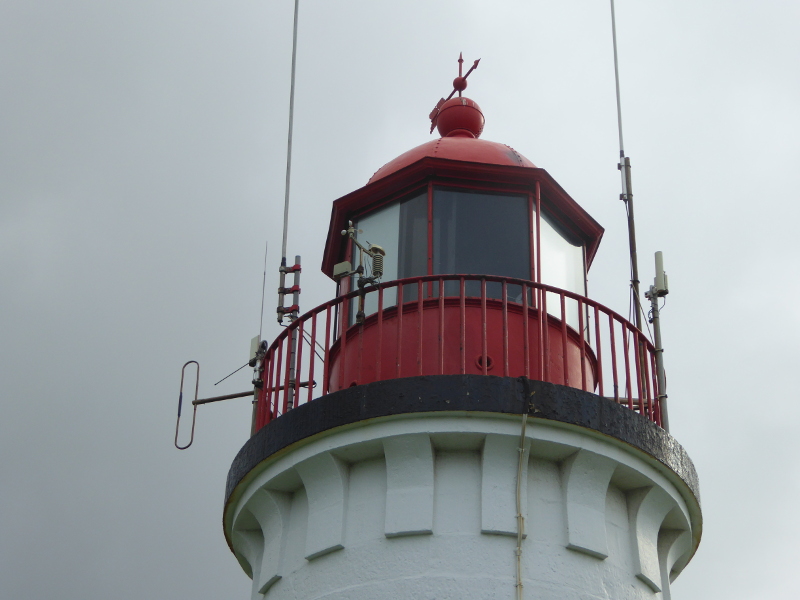
And there are benches lined up on the cliff edge to look out over the water, where presumably at certain times of the year you can spot whales, since this was the whale-spotting bluff in those days when spotting whales meant then going out to try to harpoon them afterwards. One story from Trove spoke of whale bones still lying embedded in the sand on the beach below the lighthouse, though I imagine they too are long gone.
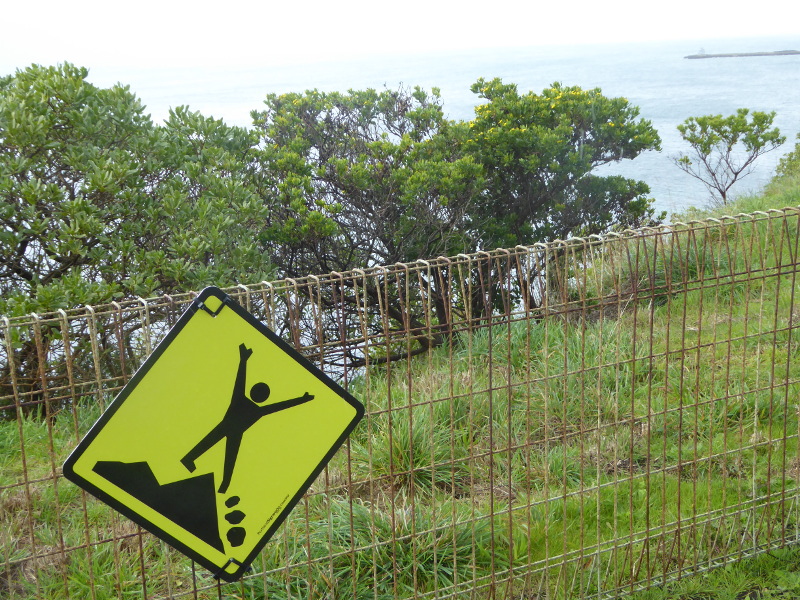
And there isn’t much chance these days of peering over to look for those from up on the clifftop.

There’s no shelter here, though, and with squally showers blowing in every five minutes or so, we didn’t stay long, or even allow ourselves time to have a good look around for other interesting or quirky things.
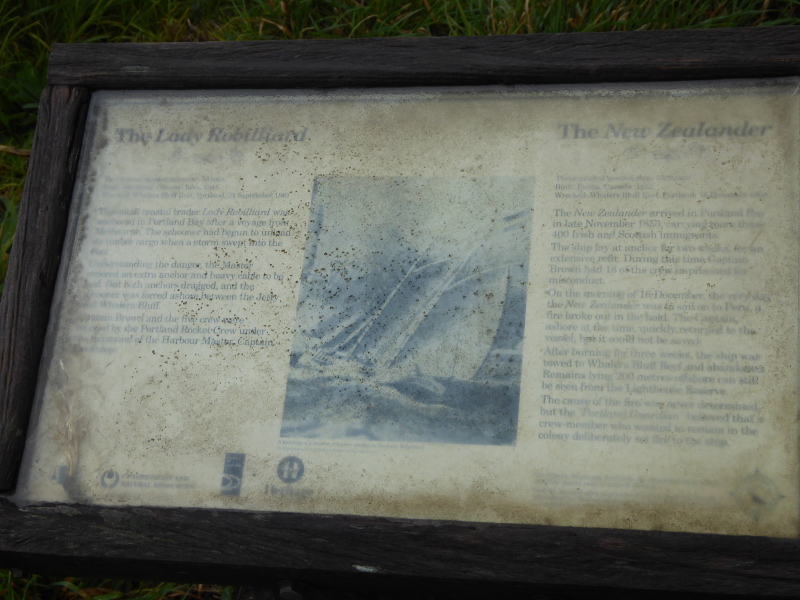
The notice on the cliff edge by the benches speaks of two ships which wrecked just below Whalers Bluff over 100 years ago: The New Zealander went down before the original lighthouse was even built on the other side of town, but it was an intriguing story I’d love to read more about, with 400 Irish and Scottish immigrants on board, and crew members imprisoned for misconduct, and one of them was suspected of setting fire to the boat to avoid the ongoing voyage towards Peru! What intrigued me also, was that the remains of the New Zealander is apparently visible still today at low tide, but again no sign of it for us that day.
The Lady Robilliard went down in 1867, while the Portland Lighthouse was still on Battery Point, though it was more to do with a sudden storm in the bay than any navigational error, so again the lighthouse was not really a factor.
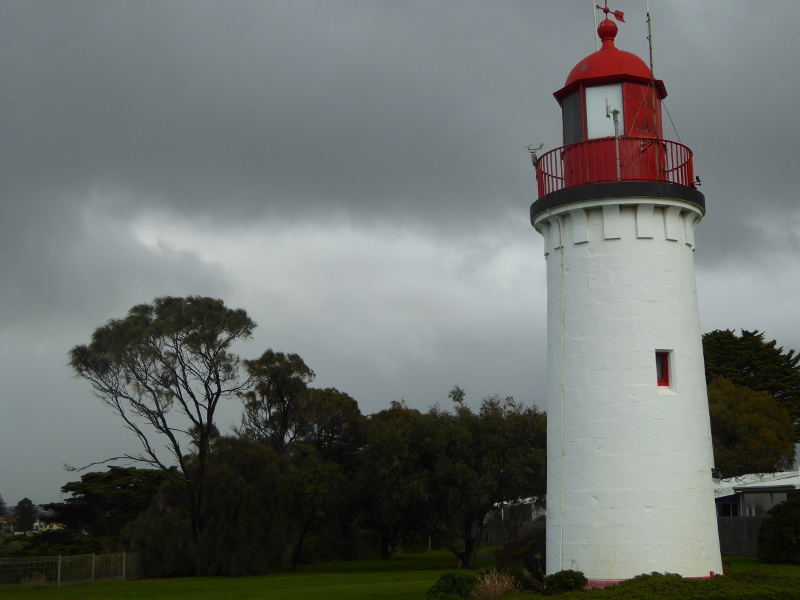
There are great views out over the bay from Whalers Bluff, and on a nice day, it must be fabulous to look out and see what’s going on, down in the port or out to sea. With another heavy shower blowing in, though, we rushed back to the car and headed off for Cape Nelson.
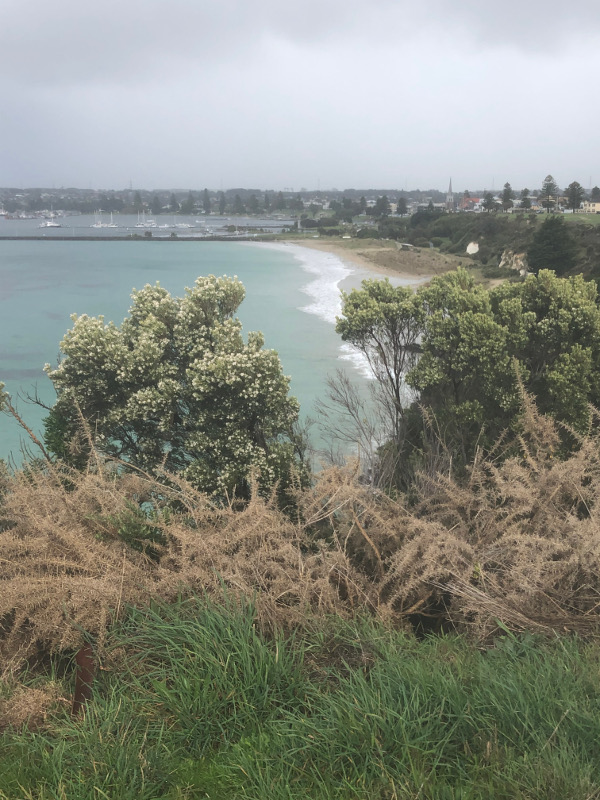
There is a vintage tram up to a terminus stop not far from the Whalers’ Bluff Lighthouse. It supposedly runs every day, but not on the day we were in town, in mid-winter, with inclement weather, and certainly no cruise ships in port to bring tourists to the town, at least until the COVID crisis is over…And I’m not sure the tram will warrant a Vintage Victoria trip in its own right: the rolling stock might be vintage, but the route was apparently built in 1996!
Practicalities
No entrance to this lighthouse, as far as I could see.
You can catch the vintage tram up from the town centre to a stop just a few hundred yards from the lighthouse. (Not every day, though, and wasn’t running on the windy winter’s day we were here)
Benches on the grassy reserve near the lighthouse, looking out to sea.
History and stories
The original Portland Bay Lighthouse – same building – started operating on 1st September 1859 on Battery Point or Observatory Hill.
William Dutton claimed to be the first whaler to settle in Portland (some call this the first white settlement of the area, rather than the Henty family arrival in 1834). Dutton killed 100 whales off the Portland coast during his time in the area, the last of which was done with the help of the Portland lighthouse keeper, who first spotted that 100th whale out in the bay. This was in 1866, when the lighthouse was still on the other hill across Portland.
In 1873 there was a hut on the Bluff to assist people hoping to catch sight of a whale and bits of whale skeleton in the sand below the Bluff, though all of this pre-dates the lighthouse being here. The Bluff was also apparently where the first settler crops in the area were grown.
In 1876 the Julia Percy (involved in a collision near another Vintage Victoria site – Cape Otway Lighthouse – a few years later) was involved in trying to haul a stranded ship which got caught on the sandbanks near Whalers Bluff. At that stage the lighthouse was still not on the Bluff.
That same year a local man carrying just a gun cleaner (as you did in those days, obviously) fended off a 5 foot long octopus with his implement, as he waded in the water below the original lighthouse position. It came at him with a fierce grip twice before heading back out to sea. He feared for the lives of any but the very strongest men who might be in the water swimming if the ‘beast’ returned.
In June 1876, the Portland Guardian seemed to say the lighthouse where it was then was ‘practically valueless’, though I’m not sure why…
The first lighthouse keeper was John Eastman, who was posted here from the opening day until he died in 1881, after which there were stories of local fund-raising for his widow – now there’s another theme to follow up one day – how did lighthouse widows survive back in those days?
I liked the sound of Keeper McDonald (1897-99), who was famed locally for his bagpipe playing, and his kids for their Highland Dancing! Keeper Squires and his family reported a minor earthquake at the Lighthouse in 1912, but then in 1915 the lighthouse was fully automated, with the harbor master put in charge of its maintenance and taking meteorological readings.
In 1888 the Lanoma, on its way from Tasmania to London, came ashore near the Portland Lighthouse. The captain thought he had got past the lighthouse and that the light his mate saw must have been from a boat, a mistake that proved fatal. The cargo of wool floated free of the wreck but those bales of wool impeded some efforts to swim to shore, one man trying three times to swim his way through them but running out of strength.
1889 saw the big guns moved onto Battery Point so plans were put in place to move the whole lighthouse over to North Bluff before it was renamed Whalers Bluff, or Whalers Point. It wasn’t a quick move, though, and by May 1890 tenders were still being called for the contract to remove the lighthouse. By late 1890 the removal was complete but the lantern was still not transferred over by January 1891.
A member of the lighthouse staff survived being struck by lightning in 1903.
Schoolgirl Katie Veitch from Casterton (aged 12 in 1905) wrote to the local paper about her month-long holiday in Portland, during which she climbed to the balcony of the lighthouse to admire not only the views, but also the highly polished brass work in the tower. She also got to watch the flags raised when a steamer went past. No such action these days at this lighthouse.
So little happened here that when an unidentified ship was spotted steering a dangerous course past Portland in 1909, causing lighthouse staff and locals to watch with concern, and the lighthouse to signal danger towards the vessel, it made quite a few column inches in the local newspaper. Nothing happened to the vessel, it seems, but those worries were newsworthy!
Messages in a bottle really did turn up on beaches. In 1910 a boy found one near the Portland Lighthouse with a message from the mate of a boat which had wrecked off King Island, saying that all crew had got off safely, but that their supply of water was running out. By the time the bottles reached shore some 4 weeks later, the crew had already been rescued by people living on the island, but it must have been a nice discovery for the boy in question, who wasn’t named in the newspaper.
A 1948 gale blew away the balcony of the lighthouse. I am assuming that was the walkway around the light. Not a good moment to be up there, then.
The last article on Whaler’s Bluff Lighthouse on the Trove database – from March 1952 – spoke of housing commission homes being built on the lighthouse reserve to house workers needed to develop the port of Portland. Some were prefab, so almost certainly knocked down when new housing was wanted, but I wondered if any of the stone and brick veneer homes from the 1950s remain. And where might the keeper’s cottage have once been? Was there ever one? And if so, did it survive more recent developments?
What are your experiences at Whaler’s Bluff Lighthouse?
Has anybody been inside the Whalers Bluff lighthouse and can help with a description of the inside?
Can anyone fill us in on when all the original housing near the lighthouse disappeared and the new buildings put up? And what about the old keepers’ cottages? Are they still in use?
Or does anyone just have a good story about Whalers Bluff Lighthouse that they’d like to share here?
Other links and writings on the Whalers Bluff Lighthouse
This is the Lighthouses of Australia website entry on Whalers Bluff. I like the quote on instructions to early keepers not to allow views of defence facilities near the lighthouse…
The ABC’s Jeremy Lee got to go inside the lighthouse 2008
Julia Powell has some beautiful photos on her visit in 2016, including night-time shot
I liked this simple 1950s photo from the Maritime Museum collection
“All the Go Bro” blogger visited the lighthouse as part of his trip to Portland.
Looking ahead as I write this, the US Lighthouse Society will be visiting in November 2021, COVID permitting, of course


Thank you for sharing this very comprehensive piece of Australian lighthouse history with us. Much enjoyed!
Glad you enjoyed it, Sue
Great article! Infact great website. I’ve been to Portland many times the past 12 years and always make sure to give this little lighthouse a visit.
As we speak, it’s a balmy 16c here right now in January and the wind up at the lighthouse earlier felt like it was 12!
Thanks Paul, glad you are enjoying the site. And the temperatures…
Thank you extremely interesting & informative.